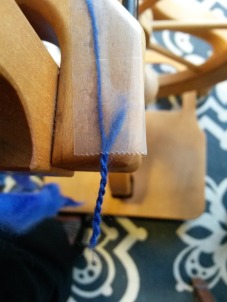New spinners fixate on thin yarn. After making super thick, slubby yarn, thin yarn looks like the sign of an expert spinner, a person with mad skills and precision control!
Actually, thin yarn isn’t the big spinning challenge. Variation in wraps per inch & twists per inch show more in a worsted weight single than in a laceweight single. No one type of yarn stands out over another. For me, a spinning rockstar can spin exactly what he or she wants within the limits of the fiber type.
I started spinning with a spindle like a boat anchor, a small bag of dense, lightly felted roving, and a thin book called Hands On Spinning. The information in the book WASN’T working for me. It is an excellent book, and I highly recommend it if you are someone who follows directions. It asks you to start out hand twisting a little piece of string. I spent about 20 seconds on that & then jumped straight to the ‘flick that spindle’ part. I wanted to spin, not hand twist fiber.
It didn’t click for me that the act of making yarn took place between my hands, not in the spindle or the wheel. I kept thinking- ah, I need a different spindle. And, if only I had a wheel.
I didn’t need a wheel or a different spindle. I needed to concentrate on learning how to manage fiber. There were tears. Lots of frustration. I learned to get the basics of drafting going by micromanaging my fiber supply. I could flick my spindle with the best of them & have enough twist for yards and yards of drafting. My hands stayed glued together and did a fair amount of double drafting and fiber play to get a consistent yarn. Eventually, it was thin, consistent yarn! But it was rock hard. Over spun, over handled. Lifeless.
To fix that, I taught myself all sorts of coping mechanisms to adapt for what was really a fundamental error in my technique. I added a cool little roll to take the extra twist out of the fiber. I predrafted like a demon. All good techniques to know, but not things I should have relied on to spin a basic single ply yarn. I didn’t care. I was spinning- a slow, tortured spinning process- but look, I could make soft and pretty yarn.
Eventually, I found a guild and saw other people spin. What they did looked so relaxing! They just sat there with some fiber in their hands, did a little hand wiggling, and yarn appeared. It was magic!
I started over, but I had lots of bad habits to unlearn.
If I am micromanaging my fiber, I remind myself to separate my hands and to check the length of my fiber staple.
I check to make sure that I am not over-tensioning the fiber supply with my fourth and fifth fingers. I’m a knitter and instinctively grab onto the fiber with those fingers. I try to remember the baby bird image (“hold your fiber like you are cradling a baby bird”). But in the end, what works best for me is envisioning the fiber sliding off of my fingers like water running over rocks.
See the post on drafting for more about this
To keep the yarn consistent, I tape a little sample to my wheel. It sits right in my line of  sight, reminding me of the goal. Every once in a while, I pull my yarn over to the sample and do a spot check. Then I check to make sure that I am keeping the density of the yarn the same. I can match the singles width, but the amount of fiber in that single will vary. (see upcoming post on Grist) This shows up when I ply, so I fold back the yarn on itself to make sure the plied yarn matches as well.
sight, reminding me of the goal. Every once in a while, I pull my yarn over to the sample and do a spot check. Then I check to make sure that I am keeping the density of the yarn the same. I can match the singles width, but the amount of fiber in that single will vary. (see upcoming post on Grist) This shows up when I ply, so I fold back the yarn on itself to make sure the plied yarn matches as well.
And last but not least, I have a control card for spot checks to make sure I am not drifting from the overall plan (assuming there is a plan!)
To use the card, I lay the single in the groove to get an estimate of the wraps per inch. This is pretty cool, so I will do a post just on control cards soon.

Wheel: Schacht Matchless Single Treadle
Fiber: Story Spun Yarns hand dyed merino roving, Very Blue
Tools: Control Card: Rosie’s Precision Spinning Control Card

